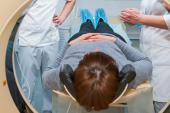Real-world Data Reiterate Value of CT-First Strategy to Rule Out Obstructive CAD
The findings are in line with what has been seen in trials like PROMISE and SCOT-HEART, one expert says.

When used as the initial test in the evaluation of patients with stable chest pain, coronary CT angiography (CCTA) is a better predictor of the need for revascularization than functional testing, real-world data show.
Looking at their own practice between 2022 and 2023, researchers led by Markus Scherer, MD (Sanger Heart & Vascular Institute, Atrium Health, Charlotte, NC), found that a CT-first strategy in patients being evaluated for chest pain was associated with revascularization for obstructive CAD in 62%. With no prior testing, the most common default strategy, the rate was just 34%.
“CTA is the only test among the noninvasive tests that actually visualizes with a good degree of precision and accuracy the amount of plaque and vessel blockages that could be causing the patient's symptoms,” Scherer told TCTMD. “You’re seeing the magnitude of atherosclerosis or coronary artery disease, and you don’t get that with other types of testing because they are indirect.”
The study was presented February 1, 2024, at the American College of Cardiology (ACC) Cardiovascular Summit in Washington, DC, by Scherer’s colleague William Downey, MD (Sanger Heart & Vascular Institute, Atrium Health).
“Despite trying our best with clinical judgment, we sometimes overestimate the likelihood that they're going to have something when we bring them to the cath lab,” Scherer added. “If you do a stress test first there can be delays . . . and you’re not getting a direct answer, so oftentimes people don’t want to wait and they take them directly to the cath lab. This study answers the question that access to [CCTA] takes away that worry and it has a rapid turnaround time.”
Numerous clinical trials have supported a CT-first strategy in the initial diagnosis of chest pain, and the most recent guideline from the ACC and the American Heart Association recommends opting for either noninvasive functional imaging or CCTA, but doesn’t specify a preference.
“While they leave both open as first-line tests, they are very clear that the evidence is stronger for CT,” noted Jonathon Leipsic, MD (University of British Columbia/St. Paul’s Hospital, Vancouver, Canada), who commented on the results for TCTMD.
In patients presenting to the emergency department with chest pain and suspected ACS, the guidelines advocate triaging patients into low-, intermediate-, and high-risk categories. For the intermediate-risk patient without known CAD, CCTA is given a class 1 recommendation for excluding atherosclerotic plaque and obstructive CAD (level of evidence A).
With regard to Scherer and colleagues’ findings, Leipsic said they are a reiteration in the form of real-world data of what RCTs like PROMISE and SCOT-HEART have shown with regard to CT being better than stress testing in informing the need for revascularization.
“This is data from a big US center and a retrospective review over a period of time that shows that the results of the randomized trials were not just isolated, they have been borne out in the real world in practice,” he added. “[CT angiography] allows the clinician to safely defer invasive angiography in some cases and to consider invasive angiography in others. What we've seen in the ISCHEMIA trial is that CT is also very, very good at confidently ruling out left main disease and stress testing simply isn't. [CT angiography] gives greater diagnostic certainty for both the clinician and the patient.”
Access and Practice Building
For the study, Scherer and colleagues retrospectively assessed 786 patients (mean age 66 years; 37% female; 13% Black) at their center who had no prior diagnosis of CAD and underwent elective coronary angiography for suspected angina.
No noninvasive testing with direct referral to angiography was the primary strategy in 44%, whereas it was CCTA in 36%, stress myocardial perfusion imaging in 15%, stress echocardiography in 3%, and stress MRI in 2%.
The yield for PCI or conversion to CABG for treatment of obstructive CAD was highest for CCTA at 62%, followed by stress MRI at 50%, stress echo at 40%, no pretesting at 34%, and stress myocardial perfusion imaging at 31%.
Scherer noted that while care needs to be individualized, the findings encourage giving a CT-first strategy strong weight and looking for ways to remove barriers to its access, which may be specific to individual centers.
“We've had problems of access in the past because we didn't have enough CT scanners and we would have patients sometimes waiting too long or physicians would change to alternative tests because of the perceived wait, so that's a big obstacle,” Scherer said. “We've worked on improving our access in our own practice, but we know this is something that many struggle with because of decades of established practice patterns, with the thinking often being that a stress test is just faster.” Currently, he said his center is approaching 10,000 coronary CTs a year.
Stress testing also can be an ingrained practice because of financial incentives to use it, Leipsic added.
“To have a CT-first practice, you have to build it by having access to the scanner, hiring people that are capable of interpreting coronary CT, training the technologists, having the quality assurance program, and it all takes time,” he said. “I think you have to see this as a journey [and as] a commitment to resource investment, hiring people, training people, supporting people. It takes years.”
Scherer said internal reviews like theirs of how individual centers are approaching chest pain evaluation and diagnosis are useful, and he encouraged others to look for themselves at what initial tests they are using.
“We are confirming what we suspected in our center and now we can encourage this [CT-first] practice more and make sure that as we encourage this practice pattern, we’re supporting access to it. When we talk to others who are interested in how we are doing this, we can share how we have removed barriers and grown to the level that we are at today,” he added.
L.A. McKeown is a Senior Medical Journalist for TCTMD, the Section Editor of CV Team Forum, and Senior Medical…
Read Full BioSources
Downey W. Real world results of a CT first strategy for evaluation of stable chest pain. Presented at: ACC Cardiovascular Summit 2024. February 1, 2024. Washington, DC.
Disclosures
- Scherer reports no relevant conflicts of interest.
- Leipsic reports consulting for Arineta.





Comments